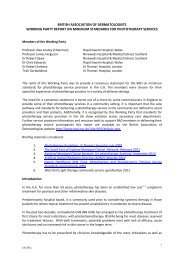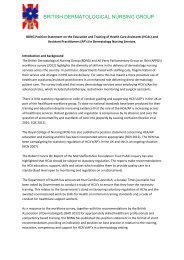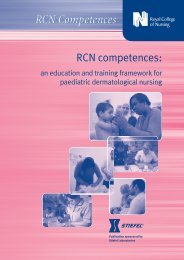Improving outcomes for people with skin tumours including melanoma
Improving outcomes for people with skin tumours including melanoma
Improving outcomes for people with skin tumours including melanoma
Create successful ePaper yourself
Turn your PDF publications into a flip-book with our unique Google optimized e-Paper software.
Cutaneous lymphoma<br />
All patients should be seen by and managed by the SSMDT, which<br />
should include a dermatopathologist <strong>with</strong> expertise in cutaneous<br />
lymphoma (NICE guidance on <strong>Improving</strong> <strong>outcomes</strong> in haematological<br />
cancers 60 ). Close liaison should be maintained <strong>with</strong> a haematooncopathologist,<br />
as appropriate. Cases of possible systemic<br />
haematological malignancy involving the <strong>skin</strong> should be referred to<br />
the appropriate haematological malignancy MDT.<br />
<strong>Improving</strong> Outcomes <strong>for</strong><br />
People <strong>with</strong> Skin Tumours<br />
<strong>including</strong> Melanoma<br />
Management of special<br />
groups<br />
LSMDTs should be involved once the diagnosis and staging has been<br />
confirmed by the SSMDT.<br />
Patients <strong>with</strong> lymphomatoid papulosis or stage Ia mycosis fungoides<br />
could be managed locally by the LSMDT after diagnosis.<br />
Patients <strong>with</strong> rare types of cutaneous lymphoma and those <strong>with</strong> later<br />
stages of mycosis fungoides (stage IIb or above) should be seen in<br />
and have easy access to supranetwork centres <strong>for</strong> specialist advice<br />
and access to treatment facilities. There should be a small number of<br />
such centres nationally and they would not be present in every<br />
cancer network.<br />
These supraregional services should be commissioned under regional<br />
specialised commissioning so that the expertise can be concentrated<br />
where the treatment facilities are available and so that tertiary referral<br />
centres can undertake clinical studies based on a meaningful number<br />
of patients.<br />
6<br />
All lymphoma patients should undergo diagnostic biopsies <strong>for</strong><br />
histology, immunophenotyping and molecular studies, and this should<br />
be correlated <strong>with</strong> clinical presentation <strong>for</strong> accurate diagnosis and<br />
prognosis.<br />
The SSMDT should have access to specialist laboratory testing of<br />
tumour tissue and blood <strong>for</strong> immunophenotyping, molecular analysis<br />
and blood viral serology.<br />
Initial staging imaging is required in all patients <strong>with</strong> the exception of<br />
stage 1 mycosis fungoides and lymphomatoid papulosis.<br />
60 National Institute <strong>for</strong> Clinical Excellence (2003) <strong>Improving</strong> <strong>outcomes</strong> in haematological<br />
cancer. Available from: www.nice.org.uk<br />
Guidance on cancer services: <strong>skin</strong> <strong>tumours</strong> <strong>including</strong> <strong>melanoma</strong><br />
119















